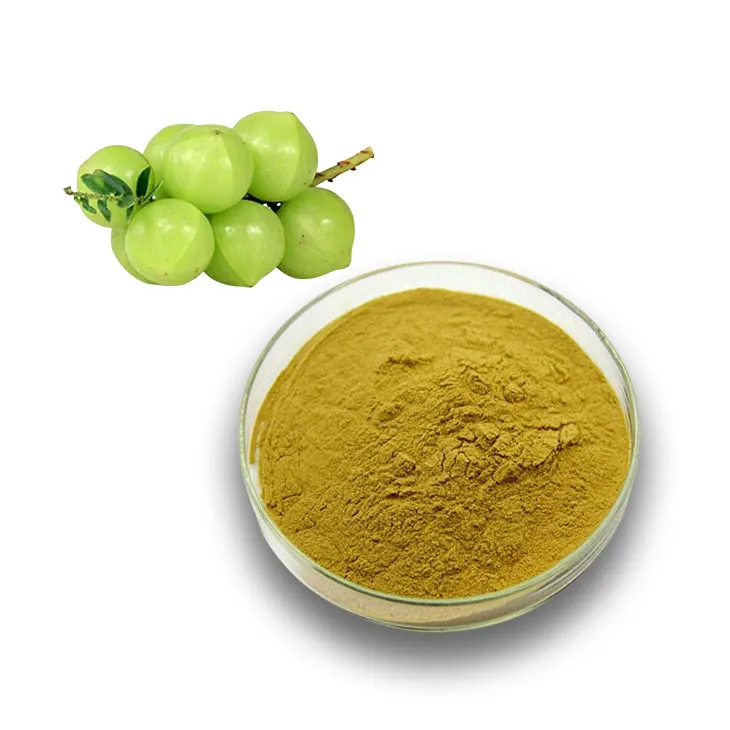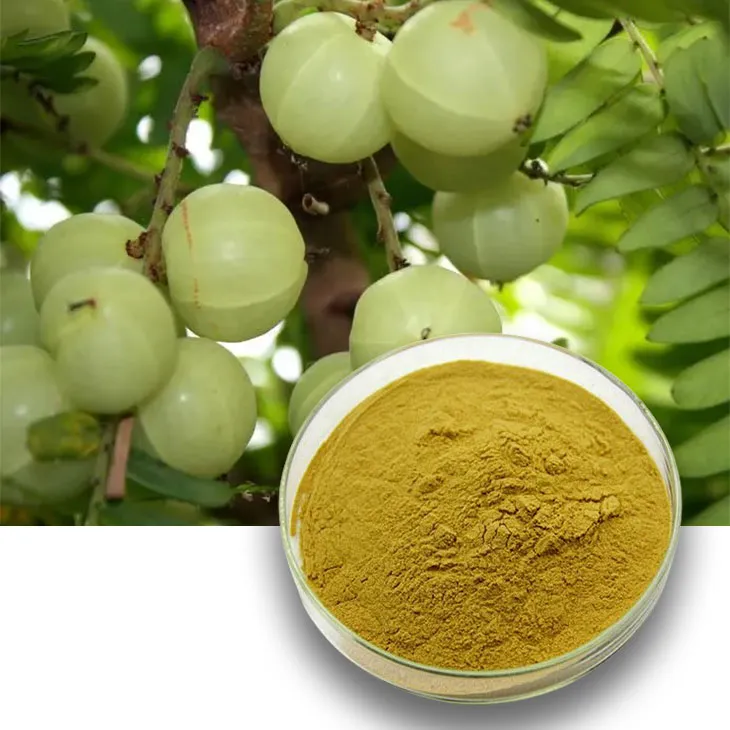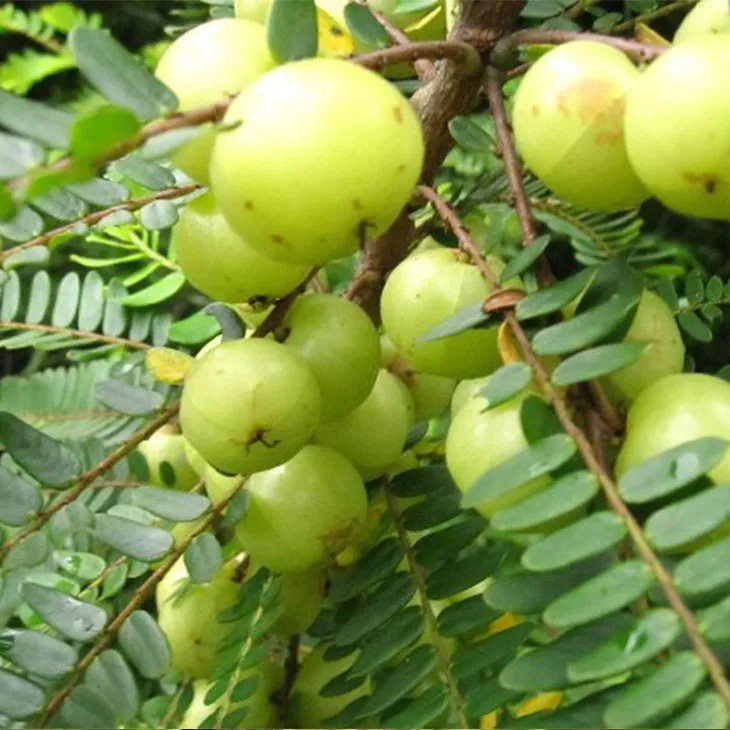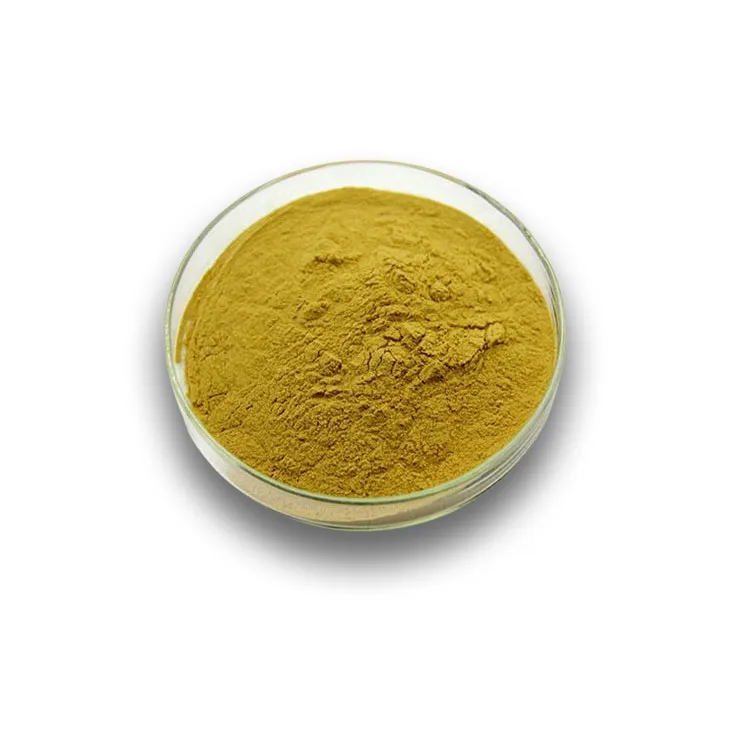- 0086-571-85302990
- sales@greenskybio.com
The process of extracting effective components from Phyllanthus emblica in Phyllanthus emblica extract.
2024-11-30

1. Introduction to Phyllanthus emblica
Phyllanthus emblica, also known as Indian gooseberry, is a remarkable plant with a long history of use in traditional medicine systems. It is native to tropical and subtropical regions and is highly valued for its numerous medicinal properties. The plant contains a rich variety of bioactive components, such as tannins, flavonoids, phenolic acids, and vitamins, which contribute to its antioxidant, anti - inflammatory, immunomodulatory, and anti - microbial activities.

2. Selection of High - Quality Raw Materials
The first crucial step in the extraction of effective components from Phyllanthus Emblica Extract is the selection of high - quality raw materials.
- Source identification: It is essential to ensure that the Phyllanthus emblica is sourced from reliable regions. Different regions may have variations in soil, climate, and cultivation methods, which can influence the quality and composition of the plant. For example, plants grown in regions with optimal sunlight, proper soil fertility, and appropriate rainfall are likely to have a higher content of active components.
- Maturity and harvesting time: The maturity of Phyllanthus emblica at the time of harvesting significantly affects the quality of the raw material. Harvesting at the right time ensures that the plant has reached an optimal stage of development, where the content of effective components is at its peak. Premature or over - ripe harvesting may lead to a lower yield of the desired components.
- Quality inspection: Rigorous quality inspection procedures should be in place. This includes visual inspection for any signs of damage, disease, or contamination. Additionally, laboratory tests can be conducted to determine the content of key active components, moisture levels, and the presence of any harmful substances.

3. Modern Extraction Technologies
Once high - quality raw materials are obtained, modern extraction technologies are employed to extract the effective components from Phyllanthus emblica.
3.1 Supercritical Fluid Extraction
Supercritical fluid extraction (SFE) is one of the most promising extraction methods for Phyllanthus emblica.
- Principle: Supercritical fluids possess properties between those of a liquid and a gas. In the case of SFE, carbon dioxide (CO₂) is commonly used as the supercritical fluid. At supercritical conditions (above its critical temperature and pressure), CO₂ can penetrate the plant matrix effectively and dissolve the target components. The solubility of different components in the supercritical fluid can be adjusted by changing the pressure and temperature conditions.
- Advantages:
- High efficiency: SFE can selectively extract the desired components with high efficiency, resulting in a relatively pure extract. It can quickly dissolve and separate the active components from the plant material, reducing the extraction time compared to traditional methods.
- Environmental - friendliness: Since CO₂ is a non - toxic, non - flammable, and easily available gas, it is an environmentally friendly solvent. After the extraction process, the CO₂ can be easily removed from the extract by reducing the pressure, leaving behind a residue - free product. This is in contrast to some traditional organic solvents that may be harmful to the environment and require complex purification steps to remove.
- Limitations:
- High - cost equipment: The equipment required for supercritical fluid extraction is relatively expensive, which may limit its widespread application in small - scale or resource - limited settings.
- Technical complexity: Operating the SFE equipment requires a certain level of technical expertise. Parameters such as pressure, temperature, and flow rate need to be carefully controlled to ensure optimal extraction results.
3.2 Solvent Extraction
Solvent extraction is a more traditional but still widely used method for extracting components from Phyllanthus emblica.
- Choice of solvents: Different solvents can be used depending on the nature of the components to be extracted. For example, ethanol is a commonly used solvent due to its ability to dissolve a wide range of bioactive compounds. Other solvents such as methanol, water, and ethyl acetate can also be considered based on the specific requirements of the extraction.
- Extraction process: The plant material is typically ground into a fine powder and then soaked in the solvent for a certain period. The solvent - plant mixture is then stirred or shaken to enhance the mass transfer of the components from the plant to the solvent. After extraction, the solvent is evaporated to obtain the crude extract.
- Advantages:
- Simplicity: Solvent extraction is relatively simple in terms of equipment and operation requirements. It does not require highly specialized and expensive equipment like SFE.
- Versatility: It can be used to extract a variety of components from Phyllanthus emblica, depending on the choice of solvent.
- Limitations:
- Solvent residue: One of the major drawbacks of solvent extraction is the potential for solvent residue in the final extract. This may require additional purification steps to remove the solvent, especially if the extract is intended for use in pharmaceutical or food applications.
- Less selectivity: Compared to SFE, solvent extraction may be less selective in extracting specific components, leading to a more complex extract containing a mixture of various compounds.

4. Refinement of the Extract
After the extraction process, the obtained extract needs to be refined to remove impurities and obtain pure and highly effective components.
4.1 Centrifugation and Filtration
Centrifugation and filtration are the initial steps in the refinement process.
- Centrifugation: This process involves spinning the extract at high speeds in a centrifuge. The centrifugal force causes the denser particles, such as cell debris, insoluble solids, and large - molecular - weight impurities, to sediment at the bottom of the centrifuge tube. The supernatant, which contains the dissolved components, can then be separated for further processing.
- Filtration: Filtration is used to further remove smaller particles and suspended solids from the extract. Different types of filters can be used, such as filter paper, membrane filters, or sintered filters. Membrane filters with different pore sizes can be selected based on the size of the particles to be removed. For example, a 0.45 - μm or 0.22 - μm membrane filter can be used to remove bacteria and fine particles.
4.2 High - Performance Liquid Chromatography (HPLC)
High - performance liquid chromatography is a powerful separation technique for obtaining pure and highly effective components from the refined extract.
- Principle: HPLC works on the principle of differential partitioning of components between a mobile phase (a liquid solvent) and a stationary phase (a solid adsorbent or a liquid - coated support). The sample is injected into the mobile phase, which then passes through the stationary phase in a column. Different components in the sample have different affinities for the stationary and mobile phases, causing them to elute from the column at different times.
- Separation and purification: By carefully selecting the appropriate mobile and stationary phases, as well as the column type and operating conditions, HPLC can separate individual components from the complex mixture in the extract. This allows for the isolation of pure active components with high precision.
- Advantages:
- High resolution: HPLC can achieve very high resolution, enabling the separation of closely related components that may be difficult to separate by other methods.
- Quantitative analysis: In addition to separation, HPLC can also be used for quantitative analysis of the components in the extract. By comparing the peak areas of the components in the chromatogram with those of known standards, the concentration of each component can be determined accurately.
- Limitations:
- High - cost equipment and consumables: HPLC equipment is expensive, and the columns and solvents used in the analysis also contribute to the overall cost. Additionally, regular maintenance of the equipment is required to ensure accurate and reliable results.
- Time - consuming: The separation process in HPLC can be relatively time - consuming, especially when dealing with complex samples. Longer analysis times may be required to achieve complete separation of all components.

5. Applications of the Extracted Components
The pure and highly effective components obtained from Phyllanthus Emblica Extract through the above extraction and refinement processes have a wide range of applications.
- Drug development: These components can be used as active ingredients in the development of drugs. For example, their antioxidant and anti - inflammatory properties make them potential candidates for the treatment of various diseases such as cardiovascular diseases, diabetes, and cancer. Research is ongoing to explore their pharmacological mechanisms and develop novel drugs based on these components.
- Health products: In the health product industry, Phyllanthus emblica - derived components are used in dietary supplements, functional foods, and nutraceuticals. They can be added to products such as capsules, tablets, and powders to provide health benefits such as boosting the immune system, improving digestion, and enhancing skin health.
- Cosmetics: The antioxidant and skin - friendly properties of the components make them suitable for use in cosmetics. They can be incorporated into skin creams, lotions, and serums to protect the skin from oxidative damage, reduce wrinkles, and improve skin complexion.
6. Conclusion
The process of extracting effective components from Phyllanthus emblica in Phyllanthus Emblica Extract is a complex and multi - step process. It involves the careful selection of high - quality raw materials, the use of modern extraction technologies such as supercritical fluid extraction and solvent extraction, and the refinement of the extract through centrifugation, filtration, and high - performance liquid chromatography. The obtained components have significant potential in various industries, including drug development, health products, and cosmetics. However, further research is still needed to fully explore the potential of Phyllanthus emblica and optimize the extraction and application processes.
FAQ:
What are the main effective components in Phyllanthus emblica?
Phyllanthus emblica contains various effective components, such as tannins, flavonoids, and vitamin C. These components contribute to its antioxidant, anti - inflammatory, and other medicinal properties.
Why is supercritical fluid extraction a good choice for extracting effective components from Phyllanthus emblica?
Supercritical fluid extraction is a good choice because it offers high efficiency in separating the desired components. It also has the advantage of being more environmentally - friendly compared to some traditional extraction methods. The supercritical fluid can penetrate the plant material effectively and selectively extract the effective components without leaving behind harmful residues.
How does centrifugation help in the process of obtaining effective components from Phyllanthus emblica extract?
Centrifugation helps by separating substances of different densities. In the context of Phyllanthus emblica extract, it can be used to remove solid impurities or larger particles that may be present in the extract. This helps in the purification process and makes it easier for subsequent steps such as filtration and further separation to obtain pure effective components.
What role does high - performance liquid chromatography (HPLC) play in the extraction of effective components from Phyllanthus emblica?
HPLC is a very important tool in this process. It can accurately separate and purify the different components present in the Phyllanthus emblica extract. By using HPLC, the pure and highly effective components can be obtained with high precision. It can separate components based on their different chemical properties such as polarity, size, and affinity, which is crucial for getting the desired active substances for further applications in drugs or health products.
Can the effective components extracted from Phyllanthus emblica be directly used in drug development?
Not always. While the effective components are a crucial starting point, further research and development are usually required. These components need to be tested for their safety, efficacy, and stability. They may also need to be formulated with other substances to enhance their performance or to make them suitable for specific drug delivery systems. Additionally, regulatory requirements must be met before they can be used in drug development.
Related literature
- Extraction and Characterization of Bioactive Compounds from Phyllanthus emblica"
- "Phyllanthus emblica: A Review of Its Phytochemistry and Pharmacological Properties"
- "Advanced Extraction Techniques for Obtaining Valuable Components from Phyllanthus emblica"
- ▶ Hesperidin
- ▶ citrus bioflavonoids
- ▶ plant extract
- ▶ lycopene
- ▶ Diosmin
- ▶ Grape seed extract
- ▶ Sea buckthorn Juice Powder
- ▶ Beetroot powder
- ▶ Hops Extract
- ▶ Artichoke Extract
- ▶ Reishi mushroom extract
- ▶ Astaxanthin
- ▶ Green Tea Extract
- ▶ Curcumin Extract
- ▶ Horse Chestnut Extract
- ▶ Other Problems
- ▶ Boswellia Serrata Extract
- ▶ Resveratrol Extract
- ▶ Marigold Extract
- ▶ Grape Leaf Extract
- ▶ blog3
- ▶ blog4
-
The best aged garlic extract on the market.
2024-11-30
-
How to make powder with L - arginine.
2024-11-30
-
Certified organic hawthorn extract.
2024-11-30
-
Bulk purchase of mulberry leaf extract.
2024-11-30
-
Wholesale Suppliers of Eyebright Extract.
2024-11-30
-
Certified organic jujube extract.
2024-11-30
-
Oyster Mushroom Extract Powder
2024-11-30
-
Senna Leaf Extract
2024-11-30
-
Purple Sweet Potato Extract
2024-11-30
-
Peppermint Oil
2024-11-30
-
Shikonin
2024-11-30
-
Marigold Extract
2024-11-30
-
Nettle leaf extract
2024-11-30
-
Citrus Aurantii Extract
2024-11-30
-
Mango flavored powder
2024-11-30
-
Oat Straw Extract Powder
2024-11-30





















